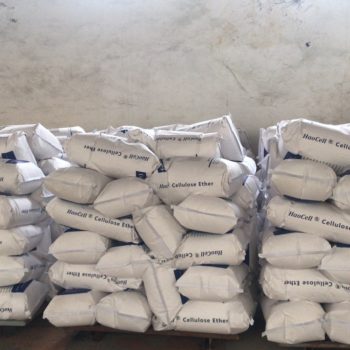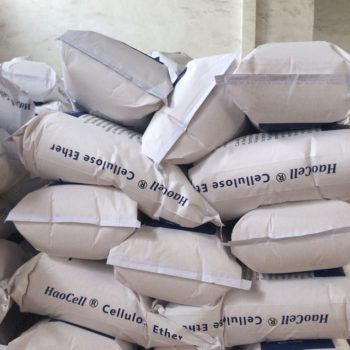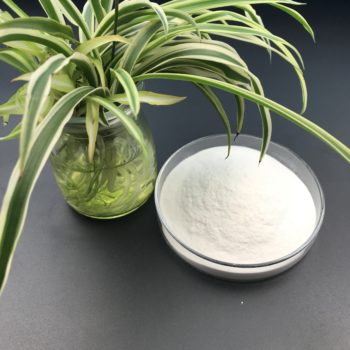Analysis and testing of hydroxypropyl methyl cellulose
1, the identification of hydroxypropyl methyl cellulose method
(1) Take 1.0g of sample, heated water (80~90℃) 100mL, stir continuously, and cool into viscous liquid in an ice bath; Put 2mL of the liquid into the test tube, slowly add 1mL sulfuric acid solution of 0.035% anthrone along the tube wall, and leave for 5min. The green ring appears at the interface between the two liquids.
(2) Take the appropriate amount of the above-mentioned slime used in the identification of (ⅰ) and pour it on the glass plate. After the water evaporates, a ductile film is formed.
2, hydroxypropyl methyl cellulose analysis of the standard solution preparation
(1) Sodium thiosulfate standard solution (0.1mol/L, validity: one month)
Preparation: Boil about 1500mL distilled water and cool until ready to use. Weigh 25g sodium thiosulfate (its molecular weight is 248.17, and try to be accurate to about 24.817g when weighing) or 16g anhydrous sodium thiosulfate, dissolve it in 200mL of the above cooling water, dilute it to 1L, and place it in a brown bottle, put the bottle in the dark, and filter it for use after two weeks.
Calibration: Weigh 0.15g of reference potassium dichromate baked to constant weight, accurate to 0.0002g. Add 2g potassium iodide and 20mL sulfuric acid (1+9), shake well, place in the dark for 10min, add 150mL water and 3ml 0.5% starch indicator solution, titrate with 0.1mol/L sodium thiosulfate solution, the solution turns from blue to bright green at the end point. Potassium chromate was not added to the blank experiment. The calibration process was repeated 2~3 times and the average value was taken.
The molar concentration C (mol/L) of sodium thiosulfate standard solution was calculated as follows:
Where, M is the mass of potassium dichromate; V1 is the volume of sodium thiosulfate consumed, mL; V2 is the volume of sodium thiosulfate consumed in blank experiment, mL; 49.03 is the mass of potassium dichromate equivalent to 1mol of sodium thiosulfate, g.
After calibration, add a little Na2CO3 to prevent microbial decomposition.
(2) NaOH standard solution (0.1mol/L, validity: one month)
Preparation: About 4.0g of pure NaOH for analysis was weighed into a beaker, and 100mL distilled water was added to dissolve, then transferred to a 1L volumetric flask, and distilled water was added to the scale, and placed for 7-10 days until calibration.
Calibration: Put 0.6~0.8g of pure potassium hydrogen phthalate dried at 120℃ (accurate to 0.0001g) into a 250mL conical flask, add 75mL distilled water to dissolve it, then add 2~3 drops of 1% phenolphthalein indicator, titrate with the above prepared sodium hydroxide solution until it is slightly red, and the end point is that the color does not fade within 30S. Write down the volume of sodium hydroxide. The calibration process was repeated 2~3 times and the average value was taken. And do a blank experiment.
The concentration of sodium hydroxide solution was calculated as follows:
Where, C is the concentration of sodium hydroxide solution, mol/L; M represents the mass of potassium hydrogen phthalate, G; V1 is the volume of sodium hydroxide consumed, mL; V2 represents the volume of sodium hydroxide consumed in blank experiment, mL; 204.2 is the molar mass of potassium hydrogen phthalate, g per mole.
(3) Dilute sulfuric acid (1+9) (Validity: 1 month)
Under stirring, carefully add 100mL concentrated sulfuric acid to 900mL distilled water, adding slowly, while stirring.
(4) Dilute sulfuric acid (1+16.5) (Validity: 2 months)
Under stirring, carefully add 100mL of concentrated sulfuric acid to 1650mL of distilled water, adding slowly. Stir as you go.
(5) Starch indicator (1%, validity: 30 days)
Weigh 1.0g soluble starch, add 10mL water, stir and inject it into 100mL boiling water, boil slightly for 2min, place it, and take the supernatant for use.
(6) Starch indicator
0.5% starch indicator was obtained by taking 5mL of prepared 1% starch indicator solution and diluting it to 10mL with water.
(7) 30% chromium trioxide solution (validity: 1 month)
Weigh 60g of chromium trioxide and dissolve it in 140mL of water without organic matter.
(8) Potassium acetate solution (100g/L, validity: 2 months)
10g of anhydrous potassium acetate grains were dissolved in a 100mL solution of 90mL glacial acetic acid and 10mL acetic anhydride.
(9) 25% sodium acetate solution (220g/L, validity: 2 months)
Dissolve 220g of anhydrous sodium acetate in water and dilute to 1000mL.
(10) Hydrochloric acid (1:1, validity: 2 months)
Mix concentrated hydrochloric acid with water at a 1:1 volume ratio.
(11) Acetate buffer solution (pH=3.5, validity: 2 months)
Dissolve 60mL acetic acid in 500mL water, then add 100mL ammonium hydroxide and dilute to 1000mL.
(12) Lead nitrate preparation solution
159.8mg of lead nitrate was dissolved in 100mL water containing 1mL of nitric acid (density 1.42g/cm3), diluted to 1000mL of water and mixed well. Preparation and storage of this solution shall be carried out in lead-free glass.
(13) Standard lead solution (validity: 2 months)
An accurate measurement of 10mL of lead nitrate preparation solution was diluted with water to 100mL.
(14) 2% hydroxylamine hydrochloride solution (period of validity: 1 month)
Dissolve 2g of hydroxylamine hydrochloride in 98mL of water.
(15) Ammonia (5mol/L, validity: 2 months)
175.25g of ammonia was dissolved in water and diluted to 1000mL.
(16) Mixed liquid (validity period: 2 months)
Mix 100mL glycerol, 75mLNaOH solution (1mol/L), and 25mL water.
(17) Thioacetamide solution (4%, validity: 2 months)
4g thioacetamide was dissolved in 96g water.
(18) Phenanthroline (0.1%, validity: 1 month)
Dissolve 0.1g o-phenanthroline in 100mL water.
(19) Acid stannous chloride (validity: 1 month)
Dissolve 20g stannous chloride in 50mL concentrated hydrochloric acid.
(20) Potassium hydrogen phthalate standard buffer solution (pH 4.0, validity: 2 months)
10.12g of potassium hydrogen phthalate (KHC8H4O4) was accurately weighed and dried at (115±5) ℃ for 2~3h. Dilute to 1000mL with water.
(21) Phosphate standard buffer solution (pH 6.8, validity: 2 months)
3.533g of anhydrous disodium hydrogen phosphate and 3.387g of potassium dihydrogen phosphate dried at (115±5) ℃ for 2~3h were accurately weighed and diluted to 1000mL with water.
(1) Determination of methoxy content
The determination of methoxy content is based on the decomposition of hydroiodate acid by heating with a test containing methoxy to produce volatile methane iodide (boiling point 42.5 ° C). Methane iodide is distilled with nitrogen in autoreaction solution. After washing to remove interfering substances (HI, I2 and H2S), the iodine methane vapor is absorbed by potassium acetate acetic acid solution containing Br2 to form IBr and then oxidized to iodic acid. After distillation, the substances in the acceptor are transferred to iodine bottles and diluted with water. After adding formic acid to remove excess Br2, KI and H2SO4 are added. The methoxy content can be calculated by titrating 12 with a solution of Na2S2O3. The reaction equation can be expressed as follows.
The device for measuring methoxy content is shown in Figure 7-6.
In 7-6 (a), A is a 50mL round-bottom flask connected with a catheter. The bottleneck is vertically equipped with a straight air condensing tube E, about 25cm in length and 9mm in inner diameter. The upper end of the tube is bent into a glass capillary tube with a downward outlet and a 2mm in inner diameter. Figure 7-6 (b) shows the improved device. 1 is the reaction flask, which is a 50mL round-bottom flask, and the nitrogen pipe is on the left. 2 is the vertical condensing pipe; 3 is the scrubber, containing washing liquid; 4 is the absorption tube. The biggest difference between the device and the pharmacopoeia method is that the two absorbers of the pharmacopoeia method are combined into one, which can reduce the loss of the final absorption solution. In addition, the washing liquid in the scrubber is also different from the pharmacopoeia method, which is distilled water, and the improved device is a mixture of cadmium sulfate solution and sodium thiosulfate solution, which can more easily adsorb the impurities in the distilled gas.
Instrument pipette: 5mL (5), 10mL (1); Burette: 50mL; Iodine measuring bottle: 250mL; Analyze the balance.
Reagent phenol (because it is a solid, so it will be fused before feeding); Carbon dioxide or nitrogen; Hydroiodate acid (45%); Analysis of pure; Potassium acetate solution (100g/L); Bromine: analytically pure; Formic acid: analytically pure; 25% sodium acetate solution (220g/L); KI: analytical purity; Dilute sulfuric acid (1+9); Sodium thiosulfate standard solution (0.1mol/L); Phenolphthalein indicator; 1% ethanol solution; Starch indicator: 0.5% starch in water; Dilute sulfuric acid (1+16.5); 30% chromium trioxide solution; Organic-free water: add 10mL dilute sulfuric acid (1+16.5) to 100mL water, heat to boiling, and add 0.1ml0.02mol /L potassium permanganate titer, boil for 10min, must keep pink; 0.02mol/L sodium hydroxide titration solution: According to the Chinese Pharmacopoeia appendix method, 0.1mol/L sodium hydroxide titration solution was calibrated and accurately diluted to 0.02mol/L with boiled and cooled distilled water.
Add about 10mL of washing solution into the washing tube, add 31mL of newly prepared absorption solution into the absorption tube, install the instrument, weigh about 0.05g (accurate to 0.0001g) of the dried sample that has been dried to constant weight at 105℃ into the reaction flask, and add 5mL hydroiodate. The reaction bottle is quickly connected to the recovery condenser (the grinding mouth is moistened with hydroiodate), and nitrogen is pumped into the tank at the rate of 1~2 bubbles per second. The temperature is controlled slowly so that the steam of the boiling liquid rises to half the height of the condenser. The reaction time depends on the nature of the sample, between 45min and 3h. Remove the absorbent tube and carefully transfer the absorbent solution into a 500mL iodine flask containing 10ml of 25% sodium acetate solution until the total volume reaches about 125mL.
Under constant shaking, slowly add formic acid drop by drop until the yellow disappears. Add a drop of 0.1% methyl red indicator, and the red color does not disappear for 5 minutes. Then add three drops of formic acid. Let it sit for a while, then add 1g of potassium iodide and 5mL of dilute sulfuric acid (1+9). The solution was titrated with 0.1mol/L sodium thiosulfate standard solution, and 3~4 drops of 0.5% starch indicator were added near the end point, and the titration was continued until the blue color disappeared.
In the same situation, a blank experiment was performed.
Calculation of total methoxide content:
Where, V1 represents the volume (mL) of sodium thiosulfate standard solution consumed by titration samples; V2 is the volume of sodium thiosulfate standard solution consumed in blank experiment, mL; C is the concentration of sodium thiosulfate standard solution, mol/L; M refers to the mass of the dried sample, g; 0.00517 is 0.1mol/L sodium thiosulfate per 1ml equivalent to 0.00517g of methoxy.
The total methoxy content represents the total methoxy and the hydroxyproxy value of the methoxy calculation, so the total alkoxy must be corrected by the resulting hydroxyproxy content to obtain the exact methoxy content. The HYDROXYPROPOXY CONTENT SHOULD FIRST BE CORRECTED FOR PROPENE PRODUCED BY THE REACTION OF HI WITH HYDROXYPROPYL WITH A CONSTANT K=0.93 (THE MEAN OF A LARGE NUMBER OF SAMPLES DETERMINED BY THE Morgan METHOD). Therefore:
Corrected methoxy content = total methoxy content – (hydroxypropoxy content ×0.93×31/75)
Where the numbers 31 and 75 are the molar masses of methoxy and hydroxypropoxy groups, respectively.
(2) Determination of hydroxypropoxy content
The hydropropoxy group in the sample reacts with chromium trioxide to produce acetic acid. After being distilled from the autoreaction solution, the content of chromic acid is determined by titration with NaOH solution. Because a small amount of chromic acid will be brought out in the distillation process, the NaOH solution will also be consumed, so the content of this chromic acid should be further determined by iodimetry and deducted from the calculation. The reaction equation is:
Instruments and reagents A complete set of instruments for the determination of hydroxypropoxy groups; Volumetric bottle: 1L, 500mL; Measuring cylinder: 50mL; Pipette: 10mL; Iodine measuring bottle: 250mL. Basic burette: 10mL; Sodium thiosulfate standard solution (0.1mol/L); Dilute sulfuric acid (1+16.5); Dilute sulfuric acid (1+9); Starch indicator (0.5%).
7-7 is a device for the determination of hydroxypropoxy content.
In 7-7 (a), D is a 25mL double-neck distilling flask, B is a 25mm×150mm steam generator tube, C is a flow connection tube, A is an electric heating oil bath, E is a shunt column, G is a conical flask with a glass plug, the end inner diameter is 0.25-1.25mm, inserted into the distilling flask; F is a condensing tube connected to E. In the improved device shown in FIG. 7-7 (b), 1 is the reactor, which is a 50mL distillation flask; 2 is the distillation head; 3 is a 50mL glass funnel to control the speed of organic water flow; 4 is nitrogen pipe; 5 is the condensing pipe. The most significant difference between the modified device and the pharmacopoeia method is the addition of a glass funnel to control the rate of water flow, so that the rate of distillation can be easily controlled.
Test methods in the sample of the 105 ℃ drying to constant weight is about 0.1 g (0.0002 g), accurate said in distillation bottle, add 10 ml of 30% chromium trioxide solution, the distillation flask into oil bath cup, oil bath liquid level consistent with chromium trioxide liquid surface, installed equipment, open cooling water, nitrogen, of our factory to control the rate of nitrogen about one bubble per second. Within 30min, the oil bath was heated to 155℃ and maintained at this temperature until the collected solution reached 50mL. The distillation was stopped to remove the oil bath.
Wash the inner wall of the cooler with distilled water, combine the washing water and the distillate in a 500mL iodine bottle, add 2 drops of 1% phenolphthalide indicator, titrate with 0.02mol/L sodium hydroxide solution to the pH value of 6.9~7.1, and write down the total number of sodium hydroxide consumed.
Add 0.5g sodium bicarbonate and 10mL dilute sulfuric acid (1+16.5) to the iodine bottle and let it stand until no carbon dioxide is produced. Then add 1.0g potassium iodide, plug it tightly, shake it well and leave it in the dark for 5min. Then add 1mL 0.5% starch indicator and titrate it with 0.02mol/L sodium thiosulfate to the end point. Write down the volume of sodium thiosulfate consumed.
In another blank experiment, the volume numbers of sodium hydroxide and sodium thiosulfate titrators consumed were recorded respectively.
Calculation of hydroxypropoxy content:
Where, K is the correction coefficient picture of the blank experiment: V1 is the volume of sodium hydroxide titration consumed by the sample, mL. C1 is the concentration of sodium hydroxide standard solution, mol/L; V2 is the volume of sodium thiosulfate titration consumed by the sample, mL; C2 is the concentration of sodium thiosulfate standard solution, mol/L; M is the sample mass, g; Va is the volume of sodium hydroxide titration consumed in blank experiment, mL; Vb is the volume of sodium thiosulfate titration consumed in the blank experiment, mL.
4. Determination of moisture
Instrumental analytical balance (accurate to 0.1mg); Measuring bottle: diameter 60mm, height 30mm; Drying oven.
The test method accurately weighs the sample 2~ 4G (



